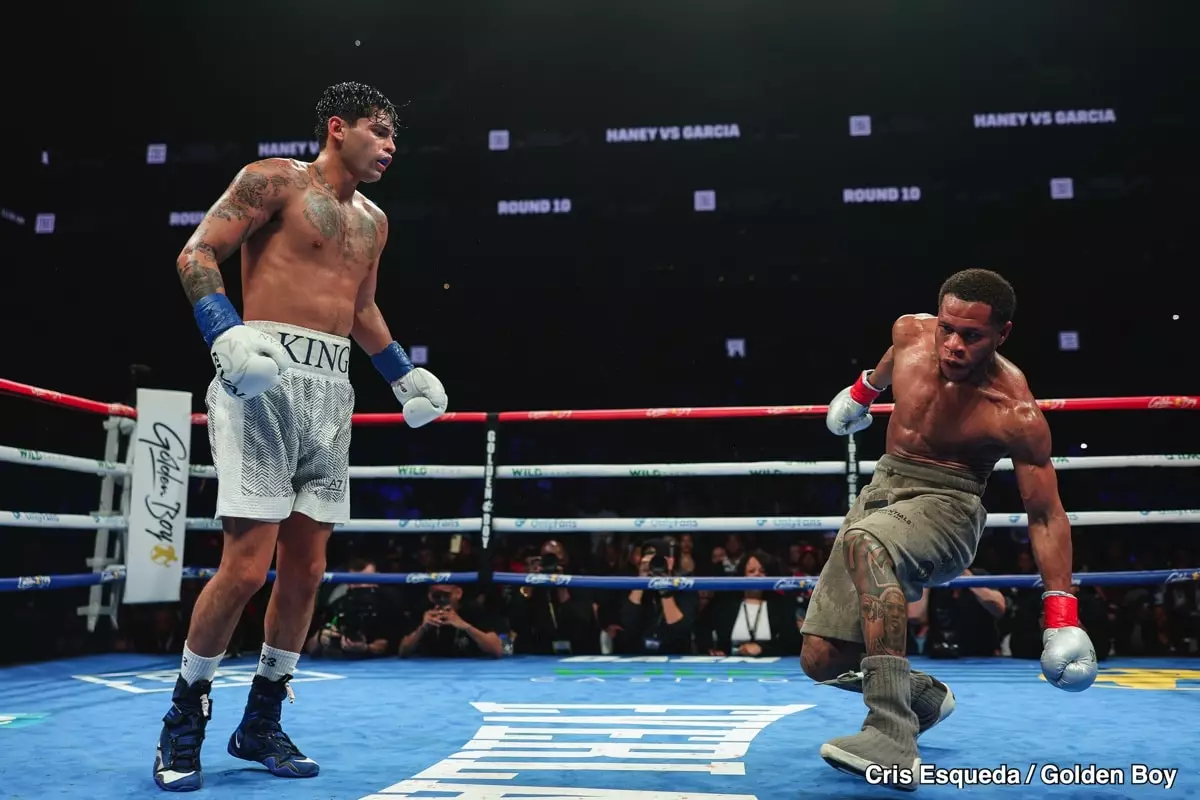The boxing world has recently been abuzz with discussions surrounding the potential for a rematch between two rising stars, Ryan Garcia and Devin Haney. While fans may yearn for a clash that could evolve into a defining moment for both boxers, Oscar De La Hoya, a significant promoter in the sport, has cast considerable doubt on the likelihood of such a showdown occurring anytime soon. De La Hoya’s comments emphasize not only his doubts about Haney’s capabilities following his defeat but also the emotional ramifications that loss may have had on the fighter.
The bout between Garcia and Haney ended in a decisive victory for Garcia, leading to a shift in the public and media perception of both fighters. De La Hoya has openly questioned Haney’s mental state and physical fitness, labeling him a “shot fighter.” This term typically denotes a boxer who may struggle to regain their former glory after experiencing a setback, particularly when that setback includes being knocked down multiple times in a single fight. In boxing, a fighter’s confidence can be as critical as their physical health, and the psychological scars from a defeat can linger long after the referee has called the bout to a close.
Moreover, Haney’s subsequent actions, including a lawsuit against Garcia for battery and fraud, have raised eyebrows. Many observers interpret this move as a sign of desperation or resignation, suggesting that Haney might be searching for vindication outside the ring instead of confronting his opponent head-on in a rematch. Legal action in the wake of a loss can indicate a fighter’s surrender to personal and professional woes, rather than a commitment to reclaiming lost glory through competition.
Oscar De La Hoya’s role as a promoter adds an interesting layer to this narrative. His assertions about Garcia indicate his intent to guide him back to prominence, underscoring the importance of mentorship in boxing. He revealed that Ryan is in “great spirits” and is focused on returning to the gym—a critical step for any fighter looking to rebound from a setback. De La Hoya reflects on his own experiences in the sport when advising Garcia, suggesting that the emotional and physical hurdles are part of a boxer’s journey. Yet, this mentorship raises questions about whether a focus on self-improvement can adequately replace the desire for revenge in the ring.
Interestingly, while De La Hoya’s confidence in Garcia shines through, he remains skeptical about Haney’s future prospects, stating that the potential for a rematch feels increasingly unlikely. This sentiment strikes at the heart of the boxing industry; it is not just the fighters’ skills that matter, but also their mental resilience and ability to navigate the narrative arcs that exist outside of the ring.
Fan sentiment plays a significant role in the shaping of a boxer’s career. The frustrations expressed by some boxing enthusiasts regarding Haney’s lawsuit provide further insight into how public perception can affect a fighter’s marketability. A fighter who is perceived to be avoiding competition may find themselves at a disadvantage in a sport where courage and face-to-face confrontation are revered. This situation illustrates how closely intertwined sports psychology and market forces can be, with the internal struggles of athletes translating into tangible effects on their public personas.
Moreover, De La Hoya’s statements encapsulate the shifting dynamics within the boxing world. If Haney cannot regain his footing and confidence in the ring, Garcia may instead seek out other rivals or opportunities—possibly even exhibition bouts in different markets, such as Japan.
In summation, both Ryan Garcia and Devin Haney stand at critical junctures in their careers. While Garcia has the momentum and the backing of influential figures like De La Hoya, Haney grapples with the aftermath of his loss and the implications of his current legal battle. For fans, the prospects of a rematch may be dwindling, as the boxing landscape continually evolves. The future remains uncertain, but one thing is clear: mental fortitude, effective mentorship, and public appeal will drive the next chapter in this intriguing narrative. Boxing is, after all, as much about the stories we share as it is about the fists that fly in the ring.

